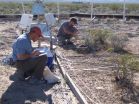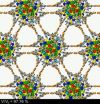(Press-News.org) VIDEO:
This animation shows the basic process of sequencing amino acids in a nanopore, using the technique of recognition tunneling.
Click here for more information.
Some three billion base pairs make up the human genome—the floor plan of life. In 2003, the Human Genome Project announced the successful decryption of this code, a tour de force that continues to supply a stream of insights relevant to human health and disease.
Nevertheless, the primary actors in virtually all life processes are the proteins coded for by DNA sequences known as genes. For a broad spectrum of diseases, proteins can yield far more compelling revelations than may be gleaned from DNA alone, if researchers can manage to unlock the amino acid sequences from which they are composed.
Now, Stuart Lindsay and his colleagues at Arizona State University's Biodesign Institute have taken a major step in this direction, demonstrating the accurate identification of amino acids, by briefly pinning each in a narrow junction between a pair of flanking electrodes and measuring a characteristic chain of current spikes passing through successive amino acid molecules.
By using a machine learning algorithm, Lindsay and his team were able to train a computer to recognize bursts of electrical activity representing the momentary binding of an amino acid within the junction. The noise signals were shown to act as reliable fingerprints, identifying amino acids, including subtly modified variants.
Proteins are already providing a wealth of information pertinent to diseases including cancer, diabetes and neurological disorders like Alzheimer's, as well as furnishing key insights into another protein-mediated process: aging.
The new work advances the prospect of clinical protein sequencing and the discovery of new biomarkers—early warning beacons signaling disease. Further, protein sequencing may radically transform patient treatment, enabling precise monitoring of disease response to therapeutics, at the molecular level.
The group's research results are reported in the advanced online edition of the journal Nature Nanotechnology.
From genome to proteome
An enormous library of proteins—known as the proteome, occupies center stage in virtually all life processes. Proteins are vital for cellular growth, differentiation and repair; they catalyze chemical reactions and provide defense against disease, among myriad housekeeping functions.
One of the strangest surprises to emerge from the Human Genome Project is the fact that only about 1.5 percent of the genome codes for proteins. The rest of the DNA nucleotides form regulatory sequences, non-coding RNA genes, introns, and noncoding DNA, (once derisively labeled "junk DNA"). This leaves humans with a scant 20-25,000 genes, a sobering discovery given that the lowly roundworm has roughly the same number. As professor Lindsay notes, the news gets worse: "A lily plant has about an order of magnitude more genes than we do," he says.
The mystery of complex organisms like humans bearing an appallingly low gene number has to do with the fact that proteins generated from the DNA blueprint can be modified in a number of ways. In fact, scientists have already identified over 100,000 human proteins and researchers like Lindsay believe this may be only the tip of the iceberg.
Just as sentences can have their meanings altered through changes in word order or punctuation, proteins generated from gene templates can change function (or sometimes be rendered inoperable), often with serious consequences for human health. Two key processes that modify proteins are known as alternative splicing and post-translational modification. They are the drivers of the extraordinary protein variation observed.
Alternative splicing occurs when coding regions of RNA, (known as exons) are spliced together and non-coding regions (known as introns) are snipped out, prior to translation into proteins. This process does not always occur neatly, with occasional overlaps of exons or introns being introduced, producing alternatively spliced proteins, whose function may be altered.
VIDEO:
ASU Regents' Professor Stuart Lindsay discusses the use of
nanotechnology for next-generation protein and DNA sequencing and its
potential impact on personalized medicine.
Click here for more information.
Post-translational modifications are markers added after proteins have been made. There are many forms of post-translational modification, including methylation and phosphorylation. Some altered proteins perform vital functions, while others may be aberrant and associated with disease (or disease propensity). A number of cancers are associated with such protein errors, which are already used as diagnostic markers. Proper identification of such proteins however remains a grand challenge in biomedicine.
New sequences
The technique described in the current research was earlier applied in the Lindsay lab for the successful sequencing of DNA bases. This method—known as recognition tunneling— involves threading a peptide through a tiny eyelet known as a nanopore. A pair of metal electrodes, separated by a gap of roughly two nanometers, sits on either side of the nanopore as successive units of a peptide are threaded through the tiny aperture, with each unit completing an electrical circuit and emitting a burst of current spikes.
The research group demonstrated that close analyses of these current spikes could enable researchers to determine which of the four nucleotide bases—adenine, thymine, cytosine or guanine—was poised between the electrodes in the nanopore.
"About 2 years ago in one of our lab meetings, it was suggested that maybe the same technology would work for amino acids," Lindsay says. Thus began efforts to tackle the substantially greater challenge of using recognition tunneling to identify all 20 amino acids found in proteins, as opposed to just 4 bases comprising DNA.
Single-molecule sequencing of proteins is of enormous value, offering the potential to detect diminishingly small quantities of proteins that may have been tweaked by alternative splicing or post-translational modification. Often, these are the very proteins of interest from the standpoint of recognizing disease states, though current technologies are inadequate to detect them.
As Lindsay notes, there is no equivalent in the protein world to polymerase chain reaction (PCR) technology, which allows minute quantities of DNA in a sample to be rapidly amplified. "We probably don't even know about most of the proteins that would be important in diagnostics. It's just a black hole to us because the concentrations are too low for current analytical techniques," he says, adding that the ability of recognition tunneling to pinpoint abnormalities on a single molecule basis "could be a complete game changer in proteomics."
The new paper describes a series of experiments in which pure samples of individual amino acids, individual molecules in mixed solution and finally, short peptide chains were successfully identified through recognition tunneling. The work sets the stage for a method to sequence individual protein molecules rapidly and cheaply (see accompanying animation).
A machine learning algorithm known as Support Vector Machine was used to train a computer to analyze the burst signals produced when amino acids formed bonds in the tunnel junction and emitted a lively noise signal as the poised electrodes passed tunneling current through each molecule. (The machine learning algorithm is the same one used by the IBM computer 'Watson' to defeat a human opponent in Jeopardy.)
Lindsay says that around 50 distinct signal burst characteristics were used in the amino acid identifications, but that most of the discriminatory power is achieved with 10 or fewer signal traits.
Remarkably, recognition tunneling not only pinpointed amino acids with high reliability from single complex burst signals, but managed to distinguish a post-translationally modified protein (sarcosine) from its unmodified precursor (glycine) and also to discriminate between mirror-image molecules knows as enantiomers and so-called isobaric molecules, which differ in peptide sequence but exhibit identical masses.
Pathway to the $1000 dollar proteome?
Lindsay indicates that the new studies, which rely on innovative strategies for handling single molecules coupled with startling advances in computing power, open up horizons that were inconceivable only a short time ago. It is becoming clear that the tools that made the $1000 genome feasible are equally applicable to an eventual $1000 dollar proteome. Indeed, such a landmark may not be far off. "Why not?" Lindsay asks. "People think it's crazy but the technical tools are there and what will work for DNA sequencing will work for protein sequencing."
While the tunneling measurements have until now been made using a complex laboratory instrument known as a scanning tunneling microscope (STM), Lindsay and his colleagues are currently working on a solid state device capable of fast, cost-effective and clinically applicable recognition tunneling of amino acids and other analytes. Eventual application of such solid-state devices in massively parallel systems should make clinical proteomics a practical reality.
INFORMATION:
Stuart Lindsay is the director of Biodesign's Center for Single-Molecule Biophysics, the Edward and Nadine Carson Presidential Chair in Physics at ASU and Regents Professor in the College of Liberal Arts and Sciences, Chemistry and Biochemistry.
Written by: Richard Harth
Science Writer: Biodesign Institute
Richard.Harth@asu.edu
Amino acid fingerprints revealed in new study
2014-04-06
ELSE PRESS RELEASES FROM THIS DATE:
Scientists find potential drug targets in deadly pediatric brain tumors
2014-04-06
BOSTON, MA (April 6, 2014) -- Researchers studying a rare, always fatal brain tumor in children have found several molecular alterations that drive the cancer, according to a new study from scientists at Dana-Farber/Boston Children's Cancer and Blood Disorders Center and McGill University. The findings identify potential new targets for drug treatments.
The new research could help physicians choose targeted agents with a better chance of combating pediatric high-grade astrocytomas, which are extremely difficult to treat with radiation and surgery. The tumors have resisted ...
Field study shows why food quality will suffer with rising CO2
2014-04-06
For the first time, a field test has demonstrated that elevated levels of carbon dioxide inhibit plants' assimilation of nitrate into proteins, indicating that the nutritional quality of food crops is at risk as climate change intensifies.
Findings from this wheat field-test study, led by a UC Davis plant scientist, will be reported online April 6 in the journal Nature Climate Change.
"Food quality is declining under the rising levels of atmospheric carbon dioxide that we are experiencing," said lead author Arnold Bloom, a professor in the Department of Plant Sciences.
"Several ...
Researchers find arid areas absorb unexpected amounts of atmospheric carbon
2014-04-06
PULLMAN, Wash.—Researchers led by a Washington State University biologist have found that arid areas, among the biggest ecosystems on the planet, take up an unexpectedly large amount of carbon as levels of carbon dioxide increase in the atmosphere. The findings give scientists a better handle on the earth's carbon budget—how much carbon remains in the atmosphere as CO2, contributing to global warming, and how much gets stored in the land or ocean in other carbon-containing forms.
"It has pointed out the importance of these arid ecosystems," said R. Dave Evans, a WSU professor ...
Friedreich's ataxia -- an effective gene therapy in an animal model
2014-04-06
The transfer, via a viral vector, of a normal copy of the gene deficient in patients, allowed to fully and very rapidly cure the heart disease in mice. These findings are published in Nature Medicine on 6 April, 2014.
Friedreich's ataxia is a severe, rare hereditary disorder which combines progressive neuro-degeneration, impaired heart function and an increased risk of diabetes. The condition affects one in every 50,000 birth. There is currently no effective treatment for this disease. In most cases, Friedreich's ataxia starts in adolescence with impaired balance and ...
Smoking visibility mapped for the first time
2014-04-06
The visibility of smoking in city streets has for the first time anywhere been mapped, in new research from the University of Otago, Wellington, New Zealand.
The research found that up to 116 smokers outside bars/cafés could be seen from any one location in the outdoor public areas of downtown Wellington (e.g. on a footpath). Of 2600 people observed in the outdoor areas of bars and cafés, 16% were smoking, with a higher proportion than this in evenings.
Data from observations across the downtown area were mapped by the researchers, producing a record of the street ...
Blood test could provide rapid, accurate method of detecting solid cancers
2014-04-06
STANFORD, Calif. — A blood sample could one day be enough to diagnose many types of solid cancers, or to monitor the amount of cancer in a patient's body and responses to treatment. Previous versions of the approach, which relies on monitoring levels of tumor DNA circulating in the blood, have required cumbersome and time-consuming steps to customize it to each patient or have not been sufficiently sensitive.
Now, researchers at the Stanford University School of Medicine have devised a way to quickly bring the technique to the clinic. Their approach, which should be broadly ...
Self-assembled superlattices create molecular machines with 'hinges' and 'gears'
2014-04-06
VIDEO:
This video shows the motion of nanoparticles in neighboring layers of the superlattice as pressure is applied.
Click here for more information.
A combined computational and experimental study of self-assembled silver-based structures known as superlattices has revealed an unusual and unexpected behavior: arrays of gear-like molecular-scale machines that rotate in unison when pressure is applied to them.
Computational and experimental studies show that the superlattice ...
Groundbreaking optical device could enhance optical information processing, computers
2014-04-06
At St. Paul's Cathedral in London, a section of the dome called the Whispering Gallery makes a whisper audible from the other side of the dome as a result of the way sound waves travel around the curved surface. Researchers at Washington University in St. Louis have used the same phenomenon to build an optical device that may lead to new and more powerful computers that run faster and cooler.
Lan Yang, PhD, associate professor of electrical and systems engineering, and her collaborators have developed an essential component of these new computers that would run on light. ...
Columbia scientists identify key cells in touch sensation
2014-04-06
VIDEO:
This video shows a Merkel cell responding to touch.
Click here for more information.
NEW YORK, NY, April 6, 2014 — In a study published in the April 6 online edition of the journal Nature, a team of Columbia University Medical Center researchers led by Ellen Lumpkin, PhD, associate professor of somatosensory biology, solve an age-old mystery of touch: how cells just beneath the skin surface enable us to feel fine details and textures.
Touch is the last frontier of ...
Catman Cohen -- "Knocking Bones & Kissing Shadows"
2014-04-06
Shadow musician, Catman Cohen, proposes to create a new CD that will be a radical departure from his past efforts. "Knocking Bones & Kissing Shadows" will aim to be the exemplar of what is considered desirable in contemporary music. Catman's 5th CD will be a raw and passionate sonic dance...sexual to the nth degree....mindless to the max....and contrived in service of a 24 hour round-the-clock orgiastic party. The music will pound and throb, the airhead lyrics will extol nothing other the celebration of genital satisfaction, buying expensive stuff, getting high, and ...









